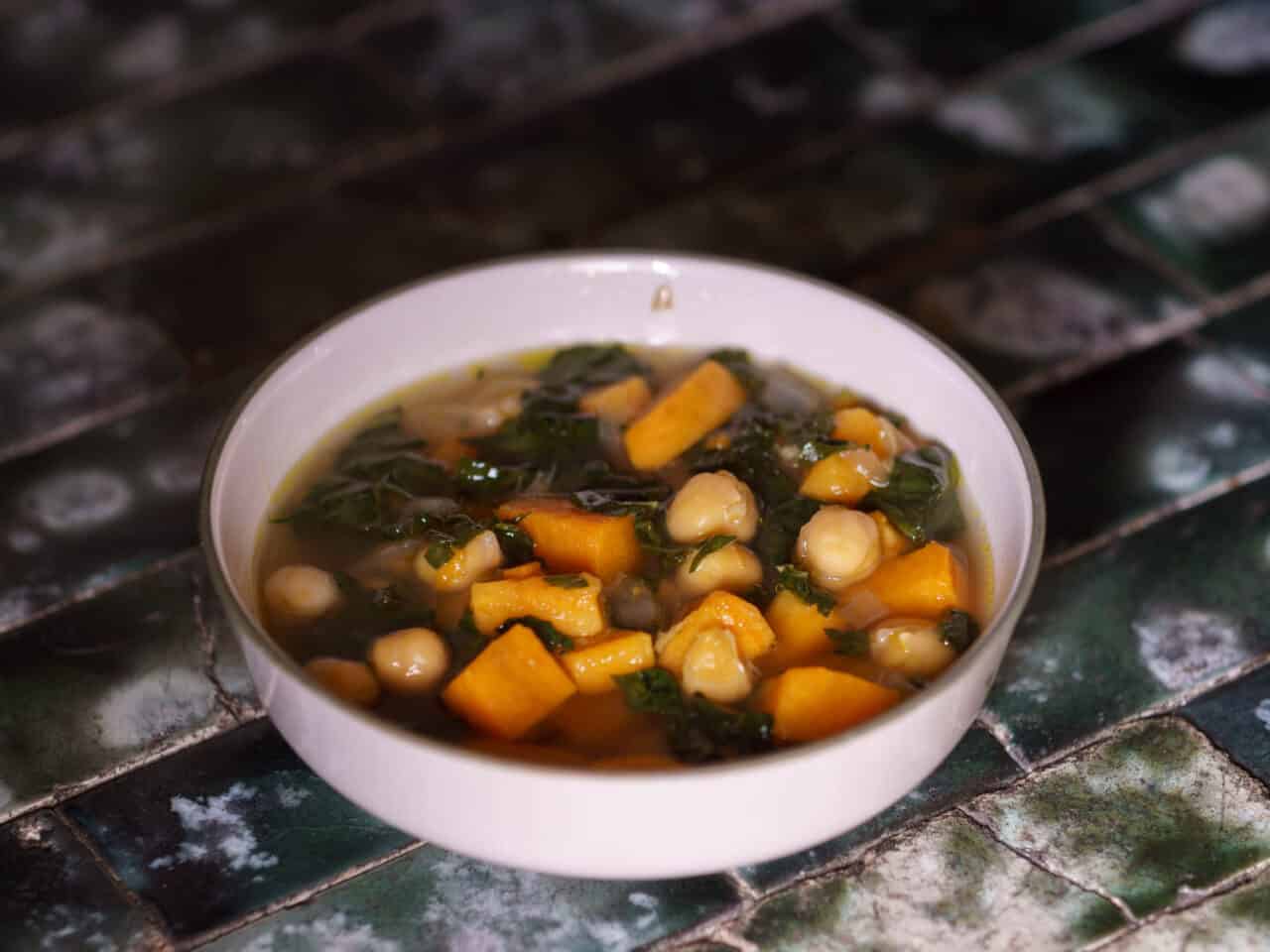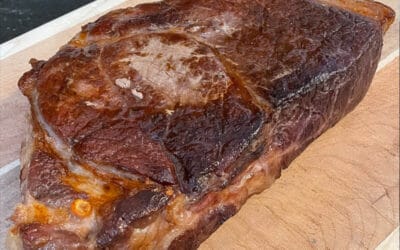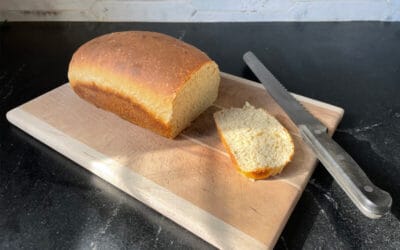The days have been sunny, but the nights are still chilly. Warm up with a dish made from market salmon and veggies.
Growing up, one of the cookbooks on our shelf was The Complete Family Cookbook. It’s a small binder, and probably a cookbook that came in sections in monthly installments: 15 sections in all. Its style screams late 60s/early 70s and many of its recipes do too. However, when I saw it at a swap I was overcome by nostalgia and brought it home.
I haven’t made many of the recipes in the book yet, but it’s one I turn to when I have ingredients but lack ideas for what to make for supper. On one such occasion I had salmon, and I found a recipe for Spanish salmon. I assumed it was Spanish in name only – much like Spanish rice – but the ingredients looked good, it was simple, and so I tried it. It was well received, a winner in our family.
When I decided to share this on the blog I did a little research on Spanish food. Although this recipe is Americanized, likely considering tastes and ingredient availability of the 60s, it keeps the key premises of Spanish cuisine, particularly Andalusian and Valencian.
To call a particular dish “Spanish” is a bit broad. Traditional dishes in Spain are highly regional and, as an article from The Spruce states, “Many times the only common ingredients are olive oil and garlic!” Olive oil is the one spot where this recipe really goes wrong: it calls for butter, though gives the option of “any melted fat.” As much as I love butter, olive oil is much more Spanish.
As I was reading up on Spanish cuisine I went on many tangents. For instance: Spain, of course, had lots of Muslim/Moroccan influence in its cuisine, due to its location and subsequent invasions/occupations. There are numerous itineraries and forums for Andalusian and Moroccan tours. All the reading about Andalucia reminded me of a hilarious movie: Spanish Affair. I had no idea that the regions of Spain were so distinct, culturally as well as gastronomically. Eventually I came back around to the faithfulness of the recipe.
To make the flavor of this dish more authentic, make a few changes. First, use olive oil instead of the butter. I’ve had some people comment that this recipe uses a lot of fat. The recipe is from the 60s, before obesity was epidemic nationally, so keep that in mind. Also, when you are cooking the onion and celery in the oil it seems about right. Cook it slowly to preserve the flavor of the oil. I’ve used a combination of butter and olive oil as well, especially on particularly cold, wet nights when some rich, hearty fare seems most appropriate.
Next, add more garlic, to taste, and leave the cloves in the finished dish. Think about how much you like in a recipe of similar quantities and go with that. Personally I would try three cloves to start. You can also add some heat, in the form of pepper flakes, or other forms of hot pepper. Or lean towards a milder pepper taste with paprika.
The herbs are correct for Spanish cuisine, though you could take a Moroccan bent with spices such as cinnamon, ginger, and/or coriander. Go for fresh herbs and spices when you can. You may want to add more to taste as well.
In addition to making the dish more Spanish, there are some other flavor boosters. It’s nice to add some more green, besides just the parsley. I used spinach near the end of cooking, though most heartier greens would work well with the long simmering time. Keep in mind the flavor they might add to the dish and keep the quantity of stronger-tasting greens quite low.
Although I’ve made this dish many times with canned tomatoes, the last couple of times I’ve used nomato sauce. It’s not the same but still allows me to have the dish I want, without the tomatoes I cannot have right now. If you choose this option, be sure to add plenty of beet for good color contrast with the salmon.
Notes on the appearance: my photos show a recipe made with nomato sauce, spinach, and salmon cut in small pieces. Tomato sauce will be more red than orange, and a nice complement to the salmon. Also, I cut the salmon smaller than what I consider “serving size” pieces. I made mine more bite-sized, knowing that’s what my kids would prefer. It turns out that I like cooking them in larger pieces so I’ll go back to that next time and let the kids cut up their own. Also, I left the skin on my salmon. That’s how I prefer it, but feel free to cut the skin off.
I’ve included the recommended menu from the cookbook, as well as the recipe for yellow rice. I imagine the rice recipe is an approachable substitute for saffron rice. Turmeric is a great spice, though, and you may have some from market. A more authentic Valencian style rice is short grained, not long, and almonds are grown in Spain, not cashews – in case you’d like to make your dish more faithful to its origins.
However you make it (Spanish cuisine is, after all, highly regional and seasonal), enjoy its nourishing goodness on a chilly winter evening.
Spanish Salmon
From The Complete Family Cookbook
Spanish Salmon:
2 pounds salmon steaks or fillets
½ cup chopped onion
1 cup chopped celery
½ cup butter other melted fat (I’ve used half or all olive oil)
¼ cup chopped parsley
1 crushed clove garlic
½ lemon
¼ tsp powdered thyme (or 1 tsp fresh thyme leaves)
1 bay leaf
¼ tsp crushed oregano (or 1 tsp fresh oregano leaves)
2 tsp salt
Dash pepper
3 cups canned tomatoes (or nomato sauce)
3 cups cooked rice (see Yellow Rice recipe)
Cut salmon in serving pieces. In a deep frying pan with a lid (I used a Dutch oven), cook onion and celery in fat until tender. Add all ingredients except fish and rice and simmer for ½ hour. Remove lemon, garlic, and bay leaf. Arrange fish in the sauce and simmer without stirring for ½ hour. Serve over cooked rice. Serves 6.
Yellow Rice:
2 tablespoons melted butter
3 chicken bouillon cubes (I used stock in place of bouillon and water)
3 cups boiling water
1 ½ cups long-grain rice
2 tablespoons sugar (I did not use this)
1 teaspoon turmeric (or use 1 tablespoon grated fresh)
½ cup finely chopped cashews
½ teaspoon salt (this assumes salted bouillon and cashews, adjust as necessary)
⅛ teaspoon pepper
In a pot dissolve bouillon cubes in boiling water. Blend in butter and rice. Bring to boil. Cover; reduce heat. Cook for 5 minutes, stirring occasionally. Blend in remaining ingredients. (I melted butter in the pot, added turmeric, pepper, and salt, then water and rice.) Recover; cook for 20 minutes until liquid is absorbed and rice is tender. Serves 6.
Options, in addition to the notes in the salmon recipe:
- Add a handful of fresh spinach or arugula near the end of cooking the salmon.
- Garnish with additional parsley.
- Add additional lemon juice, to taste.
- Use more onion and/or garlic and/or leave the garlic in after cooking
- Add paprika, either in the recipe or as a garnish
- Add pepper flakes or cook some peppers with the onions, celery, and garlic
- Use different herbs or spices such as cinnamon, ginger, coriander, cumin, and/or rosemary
- Use short-grain rice and/or almonds in place of the long-grain rice and cashews in the yellow rice
Printable recipe here





0 Comments